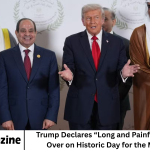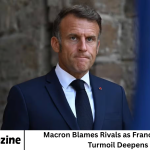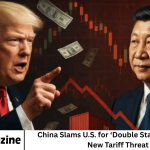As fears of another U.S. government shutdown loom large, global investors are once again seeking the security of traditional safe-haven assets — gold and silver. Both precious metals have seen renewed buying momentum in recent weeks as economic uncertainty, inflationary pressures.
- Introduction: Economic Anxiety and the Return of Safe Havens
- Gold and Silver in the Spotlight: Recent Market Trends
- Why a Government Shutdown Matters for Precious Metals
- Historical Lessons: How Gold and Silver Reacted to Past Shutdowns
- The Broader Global Context: Geopolitical and Economic Headwinds
- Middle East Tensions and Global Conflicts
- Slowing Global Growth
- Central Bank Purchases
- Inflation vs. Interest Rates
- Investor Strategies: How to Navigate the Precious Metals Rally
- Diversify but Don’t Overexpose
- Consider ETFs and Bullion
- Watch the Dollar and Yields
- Be Aware of Short-Term Volatility
- Stay Informed
- Analyst Outlook: Where Are Gold and Silver Headed Next?
- Broader Implications for Global Investors
- Frequently Asked Question
- Conclusion
For centuries, gold and silver have been synonymous with wealth preservation and financial safety. From ancient civilizations hoarding gold coins to modern investors trading ETFs, the metals’ appeal lies in their ability to hold value when everything else feels uncertain.
This resurgence of safe-haven demand underscores the timeless role of gold and silver as financial lifeboats during turbulent times. From Wall Street to Asia’s bullion markets, traders are recalibrating their portfolios to protect against potential volatility that could shake the global financial landscape.
More Read: Trump Declares “Long and Painful Nightmare” Over on Historic Day for the Middle East
Introduction: Economic Anxiety and the Return of Safe Havens
Financial markets are entering yet another period of unease as U.S. lawmakers face mounting pressure to reach a budget agreement and avert a federal government shutdown. The clock is ticking, and investors are taking no chances.
Every time Washington edges toward a fiscal standoff, risk assets like equities tend to wobble. Investors recall the painful episodes of previous shutdowns, where political dysfunction rippled through global markets, weakening the dollar and pushing gold and silver prices higher.
The latest standoff follows a familiar script — partisan divisions over spending priorities, debt ceilings, and fiscal policies. The result? Heightened uncertainty and a renewed appetite for safe-haven investments.
Gold, often dubbed the “crisis commodity,” thrives in such times. Its intrinsic value, scarcity, and historical reputation as a hedge against inflation make it a preferred refuge. Silver, while more volatile, mirrors gold’s trajectory and often outperforms during prolonged rallies due to its dual industrial and monetary nature.
Gold and Silver in the Spotlight: Recent Market Trends
Gold’s Steady Climb
In the past few weeks, gold (XAU/USD) has shown a firm upward trajectory. Spot prices have climbed above the key psychological levels near $2,400 per ounce, marking a significant rebound from earlier corrections.
Traders attribute the rally to a combination of factors — the weakening U.S. dollar, easing Treasury yields, and safe-haven demand spurred by fears of political deadlock in Washington.
Analysts at major financial institutions, including JPMorgan and UBS, suggest that gold could extend its gains if fiscal negotiations fail to yield a swift resolution. A prolonged shutdown could reduce economic output, delay federal payments, and dampen investor confidence — all bullish factors for gold.
Silver Follows Suit
Silver, often referred to as “poor man’s gold,” has also enjoyed a strong rally, with prices hovering around $30 per ounce. While its industrial demand has faced headwinds from slowing global manufacturing, the metal’s role as a store of value has attracted renewed interest.
In times of heightened geopolitical tension or economic slowdown, silver’s correlation with gold strengthens. Historically, when gold rallies due to safe-haven demand, silver tends to amplify those gains, reflecting both investor sentiment and speculative momentum.
Why a Government Shutdown Matters for Precious Metals
A U.S. government shutdown is more than just a political inconvenience; it can trigger widespread economic and financial repercussions. When government operations halt, uncertainty rises — and markets hate uncertainty.
Here’s how a potential shutdown could impact gold and silver markets:
Weaker U.S. Dollar
The U.S. dollar often weakens during fiscal standoffs as investors question the stability of government finances. A weaker dollar makes gold and silver cheaper for non-U.S. investors, thereby boosting demand and pushing prices higher.
Lower Treasury Yields
During times of uncertainty, investors tend to flock to government bonds for safety. As demand rises, yields fall — reducing the opportunity cost of holding non-yielding assets like gold.
This inverse relationship between yields and gold prices is one of the strongest drivers of precious metal performance during periods of market distress.
Inflation Concerns
A prolonged shutdown could disrupt government spending and delay crucial data releases, making it difficult for policymakers to gauge inflation trends. In such an environment, investors turn to gold and silver as hedges against both inflation and deflation risks.
Stock Market Volatility
Equity markets typically suffer during shutdowns as uncertainty over fiscal policy dampens corporate confidence. Precious metals, in contrast, tend to benefit from such volatility, as investors rebalance portfolios toward safer assets.
Historical Lessons: How Gold and Silver Reacted to Past Shutdowns
To understand today’s rally, it’s instructive to look at history. The U.S. government has shut down more than 20 times since 1976, with varying degrees of economic fallout.
- 2013 Shutdown: During the 16-day shutdown under President Obama, gold prices rose about 3% as markets fretted over the debt ceiling impasse.
- 2018-2019 Shutdown: The longest shutdown in U.S. history (35 days under President Trump) coincided with a 4% increase in gold prices. The U.S. dollar wobbled, and safe-haven flows boosted bullion demand.
- 2023 Debt Ceiling Crisis: Even without a formal shutdown, the near-default scare sent gold to then-record highs above $2,000 per ounce.
- The pattern is clear: political uncertainty translates into demand for gold and silver. Investors see these metals not just as commodities, but as financial insurance against policy chaos.
The Broader Global Context: Geopolitical and Economic Headwinds
While the U.S. shutdown fears dominate headlines, they’re not the only catalyst driving precious metals higher. A series of global developments are also adding fuel to the rally.
Middle East Tensions and Global Conflicts
Renewed geopolitical tensions in regions like the Middle East, Ukraine, and the South China Sea have created additional layers of risk for investors. Gold historically reacts positively to geopolitical crises as investors seek stability.
Slowing Global Growth
The International Monetary Fund (IMF) recently trimmed global growth forecasts, citing weaker industrial output and reduced consumer spending in major economies. Such an environment favors assets like gold and silver that hold intrinsic value even in low-growth scenarios.
Central Bank Purchases
Central banks around the world, particularly in emerging markets like China, India, and Turkey, continue to accumulate gold reserves as part of a diversification strategy. This institutional demand provides strong underlying support for gold prices.
Inflation vs. Interest Rates
Even as inflation cools in some regions, it remains above target in others. Persistent inflation coupled with uncertain monetary policy keeps investors on edge — again enhancing gold’s appeal as a store of value.
Investor Strategies: How to Navigate the Precious Metals Rally
For investors, the current environment presents both opportunity and caution. While gold and silver appear attractive, timing and strategy matter.
Diversify but Don’t Overexpose
Financial advisors recommend maintaining a modest allocation (typically 5–15%) of precious metals in a diversified portfolio. This balance provides protection without overconcentration in one asset class.
Consider ETFs and Bullion
Exchange-traded funds (ETFs) like SPDR Gold Shares (GLD) and iShares Silver Trust (SLV) offer easy exposure without the logistics of storing physical metals. For long-term investors, physical bullion or coins remain a tangible hedge.
Watch the Dollar and Yields
Gold and silver prices are inversely correlated with the dollar and U.S. Treasury yields. Monitoring these indicators can provide clues about future price direction.
Be Aware of Short-Term Volatility
Precious metals can be volatile, especially silver. Short-term traders should brace for sharp swings around political headlines or economic data releases.
Stay Informed
Macroeconomic events — from central bank announcements to fiscal negotiations — can move precious metal prices overnight. Keeping up with reliable financial news sources ensures smarter decision-making.
Analyst Outlook: Where Are Gold and Silver Headed Next?
Most analysts agree that as long as uncertainty persists, gold and silver will remain well-supported.
Gold Forecast
According to analysts at Goldman Sachs, gold could test new highs near $2,500–$2,550 per ounce if the U.S. government shutdown drags on and the Federal Reserve signals a dovish pivot in its rate policy.
A sustained decline in real yields could further reinforce this trend, making gold an even more appealing hedge.
Silver Forecast
Silver’s prospects look equally promising. Analysts project prices could approach $32–$35 per ounce in a bullish scenario. The metal’s industrial demand from renewable energy and electric vehicle sectors adds a long-term growth dimension to its traditional safe-haven status.
However, both metals could face resistance if political tensions ease quickly or if the Federal Reserve adopts a more hawkish tone to combat inflation. For now, the balance of risk favors the bulls.
Broader Implications for Global Investors
The renewed interest in precious metals also signals a broader shift in investor psychology. For much of the past decade, ultra-low interest rates and booming tech stocks lured capital away from traditional hedges.
Now, as the world grapples with inflation, fiscal instability, and geopolitical turbulence, investors are rediscovering the timeless value of gold and silver. From retail buyers in India and China to institutional investors in the West, the trend points to a collective desire for financial safety in uncertain times.
Frequently Asked Question
Why do gold and silver prices rise during government shutdown fears?
Because shutdowns create uncertainty, investors seek assets that retain value regardless of government operations. Gold and silver act as safe havens during such crises, leading to higher demand and prices.
How does a weaker U.S. dollar impact gold and silver?
A weaker dollar makes these metals cheaper for international buyers, increasing global demand. Historically, gold and silver prices move inversely to the U.S. dollar index.
Can silver outperform gold in times of crisis?
Yes. Silver often exhibits higher volatility, which can lead to stronger percentage gains during bullish precious metal rallies — though it can also fall faster when markets stabilize.
Are ETFs a good way to invest in gold and silver?
Yes. Exchange-traded funds (like GLD for gold and SLV for silver) offer convenient exposure without physical storage costs. They’re suitable for both short-term traders and long-term investors.
What role do central banks play in gold prices?
Central banks hold and purchase gold to diversify reserves and hedge against currency risk. Their consistent buying adds long-term support to gold prices.
What are the risks of investing in precious metals?
Key risks include price volatility, lack of yield (no dividends or interest), and potential short-term corrections. Investors should maintain a balanced portfolio to mitigate these risks.
Could gold and silver prices fall if the shutdown is avoided?
Possibly. If political tensions ease and economic data improve, investor confidence may return to equities, reducing safe-haven demand. However, ongoing inflation and global risks may still provide underlying support.
Conclusion
As shutdown fears grip Washington, global investors are turning to the same havens that have stood the test of centuries — gold and silver. These precious metals are more than just commodities; they are symbols of stability when markets tremble.
Whether the U.S. government manages to avert a shutdown or not, the current rally highlights the enduring relevance of these assets in preserving wealth and confidence. In a world where politics, policy, and economics intertwine to shape market behavior, gold and silver remain the ultimate refuges of trust.







